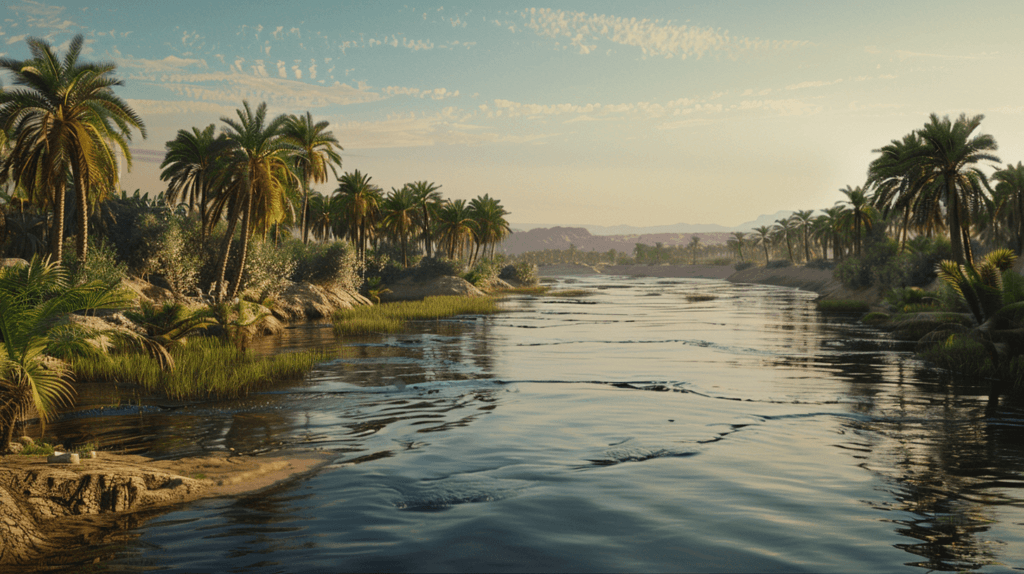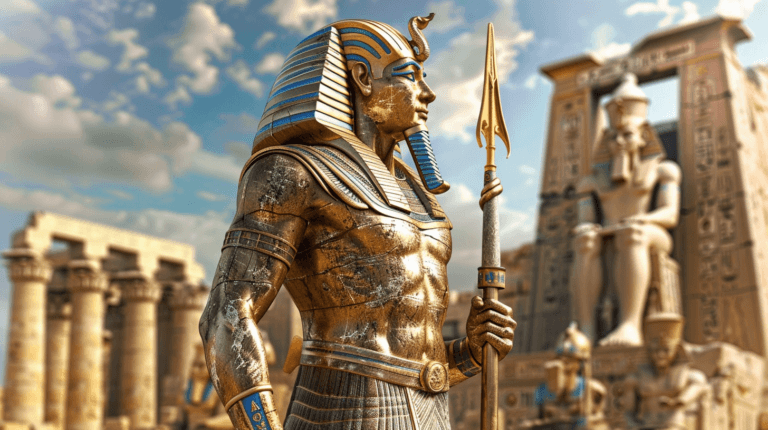How Did the Nile River Shape Ancient Egypt?
The Nile River was the lifeblood of ancient Egypt, a fundamental pillar upon which the entire framework of the civilization was built. So, how did the Nile River shape Ancient Egypt? Its predictable flooding cycle deposited rich, fertile soil onto the riverbanks, creating an agricultural haven in an otherwise harsh desert environment.
This annual event was so integral to agrarian success that the Egyptian calendar was even structured around it. The fertile land along the Nile’s edges allowed Egyptians to grow surplus crops, ultimately leading to a more settled and structured society.

The vital sustenance the Nile provided did not end with agriculture. It also served as the main transportation route, facilitating trade and communication. The Nile’s waters were teeming with fish, offering a bountiful food source, and papyrus that grew along its banks was used for building and creating paper. The river’s contribution to the livelihood of the Egyptian people fostered a profound reverence for it, weaving the Nile into the very spiritual and cultural fabric of ancient Egyptian society.
The relationship between the Nile and ancient Egypt is a testament to how geography can shape a civilization. The ancient Egyptians harnessed the river’s offerings innovatively, leading to advancements in irrigation, architecture, and technology.
Access to water played a crucial role in not just survival, but the development of one of history’s most magnificent civilizations. The Nile is not just a river in Egypt; it is a symbol of life and prosperity that shaped an empire.
Geography and the Lifeline of the Nile

The geography of Egypt is inextricably linked with the Nile River, the longest river in the world, which flows over 6,650 kilometers before draining into the Mediterranean Sea.
Course of the Nile River
The Nile River’s journey begins in the heart of Africa, with its furthest source at the Ruvyironza River, which is part of the upper headwaters of the Kagera River which feeds into Lake Victoria, associated with the White Nile. From these humble beginnings, the river continues northward, combining with the Blue Nile at Khartoum, Sudan – the Blue Nile originating from Lake Tana in Ethiopia. This confluence is a critical point in the river’s geographic journey, as the two major tributaries merge to form a singular mighty watercourse that courses through the arid landscapes of northeastern Africa.
Below is a simplified representation of the Nile River course:
| Name | Origin | Notable Confluence |
|---|---|---|
| White Nile | Lake Victoria | Khartoum |
| Blue Nile | Lake Tana | Khartoum |
| Unified Nile | Khartoum | Mediterranean Sea |
The Nile basin, an expansive drainage area spanning over 1,293,000 square kilometers, houses this complex river system. It encompasses parts of 11 countries in Africa but is dominantly associated with Egypt and Sudan.
Nile Valley and Delta
Egypt’s lifeline has intricately shaped the Nile Valley and Delta. These regions are distinctive, with the valley extending from Egypt’s southern border down to Cairo and the delta beginning north of Cairo and spreading outward to the Mediterranean Sea – this fan-shaped delta is known as Lower Egypt. The valley, referred to as Upper Egypt, is a narrow stretch of fertile land on either side of the river.
The valley and delta regions differ not just in shape but in their capacity to support life. The narrow strip of the valley is surrounded by inhospitable deserts on both sides, making the riverbanks a narrow green lifeline running through the sand.
The broader delta, in contrast, has allowed large settlements to arise thanks to the river’s deposition of rich silt. These areas thrive agriculturally and have been the foundation of Egypt’s history and economy for thousands of years, providing fields for crops such as wheat and papyrus.
Two key subsections of the Nile in Egypt are:
Nile Valley (Upper Egypt)
- Narrow fertile band
- Surrounded by Eastern and Western Deserts
Nile Delta (Lower Egypt)
- Broad, expansive delta
- Rich with river silt, supporting vast agriculture and settlements
Agriculture and Irrigation Systems

In my study of ancient Egypt, I have found that the Nile River’s annual flooding and the resulting fertile soil were central to the development of sophisticated agricultural and irrigation techniques.
Farming Seasons and Crops
The ancient Egyptian farming calendar revolved around the three seasons dictated by the Nile’s flooding cycle: Akhet (inundation), Peret (growing), and Shemu (harvesting). During Akhet, from June to September, the Nile flooded, covering the land with rich, black silt. After the floodwaters receded, the Peret season began. This was the time to sow the seeds. Egyptians primarily grew wheat and barley—staples for their diet.
Farmers also cultivated flax which was used for making linen, and a variety of vegetables like onions and garlic. They strategically utilized the nutrient-rich soil left behind by the floods to reap bountiful harvests.
Development of Irrigation
To manage the water from the floods, Egyptians developed an ingenious basin irrigation system. This technique involved constructing a network of earthen banks that formed basins to trap the water and sediment.
These basins would hold water which gradually seeped into the soil, effectively irrigating the land. My research indicates that leverage and counterbalance lifts were later innovations to raise water to higher levels when natural inundation was insufficient.
Through the use of these irrigation systems, ancient Egyptians converted vast areas of the desert into arable farmland, which provided them with the necessary food resources to thrive as a civilization. The successful management of the Nile’s waters for agriculture became a cornerstone of ancient Egypt’s economic and social development.
Cultural and Religious Significance

The Nile River was not only the lifeblood of Egypt’s agriculture but also the backbone of its cultural and religious identity. I’ll explore how the Nile’s gods and myths permeated daily life and how its influence extended to the realms of art and architecture.
Gods and Myths of the Nile
The gods of ancient Egypt were closely linked to the Nile River, and the river’s annual flooding was attributed to the divine. The most noteworthy among these gods was Osiris, the god of the afterlife and resurrection. Osiris symbolized rebirth and fertility, parallel to the Nile’s annual renewal of Egypt’s lands.
Another prominent deity was Hapy, the personification of the Nile’s floods. Festivals and rituals were frequently held in honor of these gods, entwining the Nile with religious observances.
- Osiris: God of the afterlife, connected with Nile’s renewal.
- Hapy: Symbolized the flood and fertility of the Nile.
The Nile’s influence carried over to the pharaoh, who was considered a god on Earth. The pharaoh’s ability to control the Nile’s waters through rituals was a testament to their divine power. These divine associations fortified the pharaoh’s central role in both the governance and spirituality of ancient Egypt.

Influence on Art and Architecture
The architecture of ancient Egypt mirrors the devotion its people had for the Nile River. The iconic pyramids, colossal, monumental tombs, and the Great Sphinx are enduring testaments to the Nile’s impact.
Temples often featured depictions of gods like Osiris and Hapy, and strategic placement of these structures along the Nile’s banks was a common practice. Indeed, the river provided not only a means for transporting building materials but also inspiration for designs that reflected its centrality in Egyptian life.
- Pyramids: Often positioned to reflect Nile’s cardinal significance.
- Temples: Sited by the Nile, incorporating river motifs in design.
Art, too, was heavily influenced by the Nile. Frescoes and bas-reliefs in temples and tombs were filled with Nile imagery—crocodiles, hippos, and lotuses—and portrayed the river as a source of sustenance and spiritual passage. All these facets of art and construction highlight how the ancient world’s greatest river shaped one of its most enduring civilizations.
Economic Impact and Trade

The Nile River was key to Ancient Egypt’s economic success. We’ll explore how it helped with transportation, communication, and trade.
Transportation and Communication
Reliance on the Nile for transportation was not just a matter of convenience but a strategic economic choice. Boats traveling along the Nile were the backbone of commerce, allowing goods and people to move efficiently throughout the empire.
This network facilitated fast communication and to trade goods quickly, including valued papyrus, which was crucial for record-keeping and correspondence. A well-organized transportation system tied the huge empire together.
Trade Networks and Expansion
The Nile River established vast trade networks and was key to securing economic expansion It was the highway to wealth!
Access to the Mediterranean, enabled trade with the Greeks and other civilizations, exporting commodities such as grain, linen, and the highly demanded papyrus reeds. In turn, items including spices, incense, ebony, and ivory were imported. This exchange was instrumental to prosperity and helped secure Egypt as one of the greatest powers of the ancient world.
- Exports: Grain, Linen, Gold, Papyrus
- Imports: Spices, Incense, Ebony, Ivory
- Key Trading Partners: Greeks, Nubian, Punt, Canaan
The strategic location of the Nile not only propelled internal trading activities but also bolstered external economic relations, effectively shaping the commercial landscape of Ancient Egypt.
How Did the Nile River Shape Ancient Egypt?
The Nile River wasn’t just Egypt’s lifeline; it was its heartbeat, turning a harsh desert into an agricultural marvel with its annual floods, shaping the very calendar of ancient society. This mighty river fueled not only crops but commerce, connecting Egypt to distant lands through intricate trade networks, and it flowed deep within the spiritual and cultural veins of its people, inspiring awe and reverence. The Nile’s enduring legacy is a testament to how nature can sculpt civilizations, birthing an empire where the rhythm of life danced to the pulse of its waters.
Why is the Nile River Important?
Ancient Egypt owes its existence to the Nile River—without it, the civilization might never have flourished. Along its banks, I find the impressive burst of culture and innovation, from the construction of monumental pyramids to the development of a 365-day calendar. The predictable flooding of the Nile not only supported agriculture but also helped the Egyptians become masters of planning and organization.







